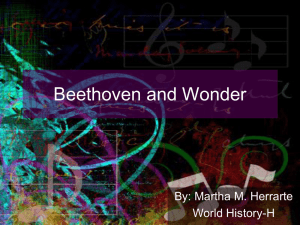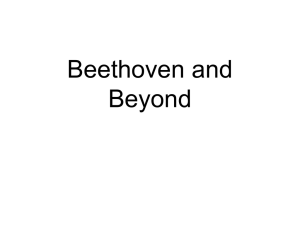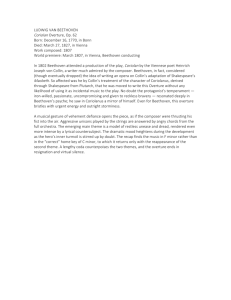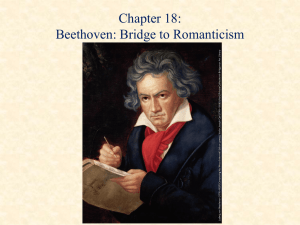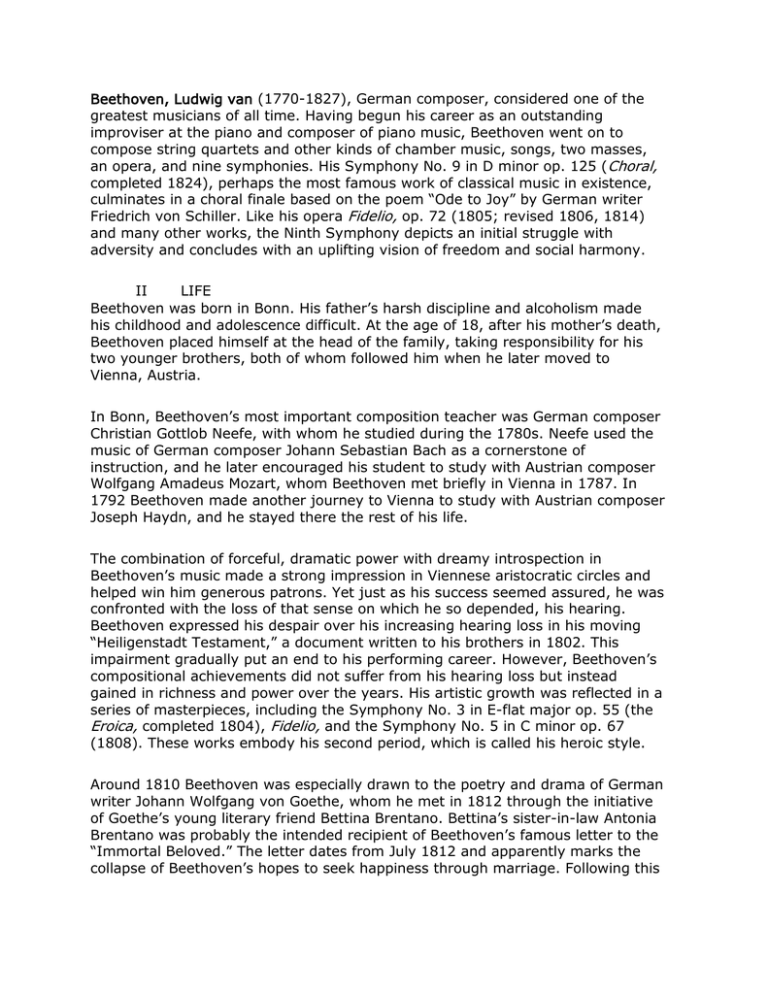
Beethoven, Ludwig van (1770-1827), German composer, considered one of the
greatest musicians of all time. Having begun his career as an outstanding
improviser at the piano and composer of piano music, Beethoven went on to
compose string quartets and other kinds of chamber music, songs, two masses,
an opera, and nine symphonies. His Symphony No. 9 in D minor op. 125 (Choral,
completed 1824), perhaps the most famous work of classical music in existence,
culminates in a choral finale based on the poem “Ode to Joy” by German writer
Friedrich von Schiller. Like his opera Fidelio, op. 72 (1805; revised 1806, 1814)
and many other works, the Ninth Symphony depicts an initial struggle with
adversity and concludes with an uplifting vision of freedom and social harmony.
II
LIFE
Beethoven was born in Bonn. His father’s harsh discipline and alcoholism made
his childhood and adolescence difficult. At the age of 18, after his mother’s death,
Beethoven placed himself at the head of the family, taking responsibility for his
two younger brothers, both of whom followed him when he later moved to
Vienna, Austria.
In Bonn, Beethoven’s most important composition teacher was German composer
Christian Gottlob Neefe, with whom he studied during the 1780s. Neefe used the
music of German composer Johann Sebastian Bach as a cornerstone of
instruction, and he later encouraged his student to study with Austrian composer
Wolfgang Amadeus Mozart, whom Beethoven met briefly in Vienna in 1787. In
1792 Beethoven made another journey to Vienna to study with Austrian composer
Joseph Haydn, and he stayed there the rest of his life.
The combination of forceful, dramatic power with dreamy introspection in
Beethoven’s music made a strong impression in Viennese aristocratic circles and
helped win him generous patrons. Yet just as his success seemed assured, he was
confronted with the loss of that sense on which he so depended, his hearing.
Beethoven expressed his despair over his increasing hearing loss in his moving
“Heiligenstadt Testament,” a document written to his brothers in 1802. This
impairment gradually put an end to his performing career. However, Beethoven’s
compositional achievements did not suffer from his hearing loss but instead
gained in richness and power over the years. His artistic growth was reflected in a
series of masterpieces, including the Symphony No. 3 in E-flat major op. 55 (the
Eroica, completed 1804), Fidelio, and the Symphony No. 5 in C minor op. 67
(1808). These works embody his second period, which is called his heroic style.
Around 1810 Beethoven was especially drawn to the poetry and drama of German
writer Johann Wolfgang von Goethe, whom he met in 1812 through the initiative
of Goethe’s young literary friend Bettina Brentano. Bettina’s sister-in-law Antonia
Brentano was probably the intended recipient of Beethoven’s famous letter to the
“Immortal Beloved.” The letter dates from July 1812 and apparently marks the
collapse of Beethoven’s hopes to seek happiness through marriage. Following this
disappointment, Beethoven’s output declined significantly, and during 1813 he
was generally depressed and unproductive.
Beethoven’s fame during his lifetime reached its peak in 1814. The enthusiastic
response of the public to his music at this time was focused on showy works, such
as Wellington’s Victory op. 91 (1813; also known as the Battle Symphony), and a
series of patriotic crowd-pleasers, including the cantata The Glorious Moment op.
136 (1814), but his enhanced popularity also made possible the successful revival
of Fidelio.
During the last decade of his life Beethoven had almost completely lost his
hearing, and he was increasingly socially isolated. He had assumed the
guardianship of his nephew Karl after a lengthy legal struggle, and despite
Beethoven’s affection for Karl, there was enormous friction between the two.
Notwithstanding these difficulties, between 1818 and 1826 Beethoven embarked
upon a series of ambitious large-scale compositions, including the Sonata in B-flat
major op. 106 (Hammerklavier, 1818), the Missa Solemnis in D major op. 123
(1823), the Thirty-Three Variations on a Waltz by Diabelli in C major op. 120
(1823), the Symphony No. 9 in D minor op. 125 (1824), and his last string
quartets. Plagued at times by serious illness, Beethoven nevertheless maintained
his sense of humor and often amused himself with jokes and puns. He continued
to work at a high level of creativity until he contracted pneumonia in December
1826. He died in Vienna in March 1827.
III
MUSIC
Beethoven’s music is generally divided into three main creative periods. The first,
or early, period extends to about 1802, when the composer made reference to a
“new manner” or “new way” in connection with his art. The second, or middle,
period extends to about 1812, after the completion of his Seventh and Eighth
symphonies. The third, or late, period emerged gradually; Beethoven composed
its pivotal work, the Hammerklavier Sonata, in 1818. Beethoven’s late style is
especially innovative, and his last five quartets, written between 1824 and 1826,
can be regarded as marking the onset of a fourth creative period.
Although Beethoven’s music of the early period is sometimes described as
imitative of Mozart and Haydn, much of it is startlingly original, especially the
works for piano. His early piano sonatas often have a forceful, bold quality, which
is set into relief by the searching inwardness of the slow movements. The Sonata
in C minor op. 13 (Pathétique, 1798), the most famous of these sonatas, transfers
Haydn’s practice of employing slow introductions to his symphonies to the genre
of the sonata. The title refers to a quality of pathos or suffering, which is felt
especially in the brooding slow introduction and is twice recalled in later stages of
the first movement. The main body of this swift, brilliant movement seems to
convey willful resistance to the sense of suffering that dominates the slow
introduction.
At the threshold of his middle period Beethoven sought a variety of new
approaches to musical form. In the Sonata in C-sharp minor (Moonlight, 1801),
he begins with a slow movement, while typical sonatas of that time began with a
fast movement. The movement’s placid motif (repeated phrase) of broken chords
is reinterpreted in the final movement as forceful figuration reaching across the
entire keyboard. The sonatas of op. 31, from 1802, each open in an original
fashion. The G major, op. 31 no. 1, begins with striking shifts in key, in contrast
to the usual practice of remaining in the same key to “ground” the listener. The D
minor, op. 31 no. 2 (Tempest), on the other hand, breaks up the opening theme
into contrasting segments in different tempi, whereas customary practice called
for stating the theme in its entirety at the beginning of a movement.
In the first movement of the Eroica Symphony, one of the major works from
Beethoven’s middle period, he again sought ways to expand upon the prevailing
musical forms. At that time, composers usually organized movements in three
major parts. First, the exposition introduces the musical themes of the piece.
Next, the development takes these themes into other keys, often modifying or
fragmenting them. Finally, the recapitulation restates the themes, grounded in the
original key. Prefaced by two massive, emphatic chords, the opening theme of the
Eroica lingers on a mysterious dark moment of harmony—a gesture that is not
reinterpreted until much later, at the outset of the recapitulation. After the
rhythmic climax of the enormous development section—it is twice as long as the
development section in any other symphony of the time—Beethoven reshapes
classical norms by introducing extensive new material, which is resolved in a sort
of recapitulation in the coda (concluding passage), which follows the movement’s
recapitulation.
The four movements of the Eroica bear the following expressive associations:
struggle, death (a funeral march), rebirth (a scherzo, or rapid dancelike
movement, that begins quietly), and glorification. In its narrative design, the
Eroica is connected to the ballet music of Beethoven’s Prometheus, op. 43 (1801),
from which he borrowed the theme for the symphony’s finale. This movement of
the symphony expresses the exaltation of the Greek mythological figure
Prometheus in a series of variations on the ballet’s theme. Beethoven had
originally intended to dedicate the work to French general Napoleon Bonaparte,
whom he idolized, but he angrily withdrew the dedication after learning that
Napoleon had taken the title of emperor.
Beethoven’s other instrumental works from the period of the Eroica also tend to
expand the formal framework that he inherited from Haydn and Mozart. The Piano
Sonata in C major op. 53 (Waldstein) and the Piano Sonata in F minor op. 57
(Appassionata), completed in 1804 and 1805 respectively, each employ bold
contrasts in harmony, and they use a broadened formal plan, in which the
meditative slow movements flow directly into the final movements. The
symbolism of the keys used for these sonatas shares in the expressive world of
Beethoven’s opera, entitled Leonore in its original version from 1805. The grim Fminor character of the Appassionata recalls the dungeon scenes in this key from
the opera, whereas the jubilant close of the Waldstein in C major recalls the
stirring C-major conclusion of the opera to the words “Hail to the day! Hail to the
hour!”
The celebrated Symphony No. 5 in C minor op. 67 from 1808 is the most
thematically concentrated of Beethoven’s works. Variants of the four-note motif
that begins this symphony drive all four movements. The dramatic turning point
in the symphony—where a sense of foreboding, struggle, or mystery yields to a
triumphant breakthrough—comes at the transition to the final movement, where
the music is reinforced by the entrance of the trombones. Beethoven uses here a
large-scale polarity between the darker sound of C minor and the brighter, more
radiant effect of C major, which is held largely in reserve until the finale.
The series of gigantic masterpieces of Beethoven’s third period include the
technically demanding Hammerklavier Sonata, completed in 1818, about which he
correctly predicted on account of its challenges that “it will be played fifty years
hence,” and the Diabelli Variations. The latter work for piano transforms a trivial
waltz by Viennese publisher Anton Diabelli into an astonishing, seemingly endless
series of pieces, each with a unique character; some are humorous or even
parodies. These and other late works incorporate fugues—melodies played in
succession and interwoven—that reflect Beethoven’s lifelong interest in the music
of J. S. Bach (known for his keyboard work Art of the Fugue). Beethoven’s second
mass, the Missa Solemnis in D major op. 123 (1823), also poses formidable
technical challenges, as do his fascinating and sometimes enigmatic last quartets
and the Ninth Symphony, whose most readily accessible movement is the choral
finale.
IV
EVALUATION
Beethoven combined the dramatic classical style of lively contrasts and
symmetrical forms, which was brought to its highest development by Mozart, with
the older tradition of unified musical character that he found in the music of J. S.
Bach. In some early works and especially in his middle or heroic period,
Beethoven gave voice through his music to the new current of subjectivity and
individualism that emerged in the wake of the French Revolution (1789-1799) and
the rise of middle classes. Beethoven disdained injustice and tyranny, and used
his art to sing the praises of the Enlightenment, an 18th-century movement that
promoted the ideals of freedom and equality, even as hopes faded for progress
through political change. (His angry cancellation of the dedication of the Eroica
Symphony to Napoleon Bonaparte reveals Beethoven’s refusal to compromise his
principles.)
The fact that Beethoven realized his artistic ambitions in spite of his hearing
impairment added to the fascination and inspiration of his life for posterity, and
the extraordinary richness and complexity of his later works insured that no later
generation would fail to find challenge in his music. Beethoven’s artistic
achievement cast a long shadow over the 19th century and beyond, having set a
standard against which later composers would measure their work. Subsequent
composers have had to respond to the challenge of Beethoven’s Ninth, which
appeared to have taken the symphony to its ultimate development.
Contributed By:
William Kinderman
1
1"Beethoven, Ludwig van."Microsoft® Encarta® Encyclopedia 2001. © 1993-2000 Microsoft
Corporation. All rights reserved.

